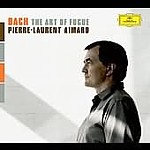In certain areas of 20th-century piano repertoire, Pierre-Laurent Aimard has few peers; think of his Ives, Carter, Messiaen, and Ligeti performances. But when it comes to earlier music, you never know what you’re going to get. For example, I heard Aimard play a stiff, colorless Beethoven Appassionata one night, and a luminous 32 Variations the next morning. His literal, matter-of-fact Schumann Symphonic Etudes recording hardly prepared me for a probing, intense Brahms D minor Concerto with David Robertson and the BBC Symphony, broadcast in 2006. In the main, Aimard’s earnest, forceful approach to much of Bach’s Art of Fugue indicates that the pianist is attracted more to the music’s rigor than to the potential for characterization its harmonic riches and often underrated melodic invention hold.
I like Aimard’s fluid, forward-moving basic tempo for the first fugue, but not his predictably accented downbeats, relatively unvaried articulation, and increasingly pounded-out main theme. His exactitude over the dotted rhythms in Contrapuncti 2 and 6 yields square and rigid results. Aimard plows through No. 4 like a horse with blinders on, while taking a lifeless crawl through the amazing canon in augmentation and contrary motion. Conversely, the Canon Alla Duodecima in Contrapunto Alla Quinta that Gregori Sokolov so boringly stretches out to eight minutes requires only two minutes via Aimard’s breezy, repeatless route.
While Aimard turns the three-voice Contrapunctus 8’s wonderous harmonic poetry into prose, he shapes its arguably more adventurous four-voice companion piece (No. 11) with far more animation and purpose. To my taste, the overlapping canonic writing midway through Contrapunctus 5 benefits from a gentler, more lyrical interpretation (i.e. Charles Rosen) than what Aimard’s sterner stewardship delivers. Aimard treats the final, unfinished fugue in a surprisingly terse, headlong, and relatively uninflected manner–the polar opposite of Gould savoring every note in slow motion. At the opposite end of the spectrum, Aimard’s sustained introspection and tonal beauty reveal the grave four-voice mirror fugues in more haunting, vulnerable light than usual. No single Art of Fugue piano recording “has it all”, so to speak, yet the Rosen and Koroliov versions still stand as references for artistic consistency.
































